-
Expand this whole thread (2 messages)
2x2 cm large gallstone flushed out, confirmed by U... BSA 100% Cured Eric B
7 m
1,029
† C †
BSA 100% Cured Eric B
7 m
1,029
† C †
2x2 cm large gallstone flushed out, confirmed by Ultrasound
These messages were posted into the " Gallstones & Gallbladder Attack Cures and Natural Remedies Research Group" on facebook.
Alexandra
Jun 12 2022
· ·
I have done my 7th flush tonight ( Hulda Clark e protocol)
Had a couple of mild attacks after a 2 months pause and decided to do it.
I have adjusted the protocol and find it way more friendly to carry out. I mix epsoms with 70% apple juice 30% water, and mix oil and grapefruit juice really well in a glass jar with lid and drink it with closed nose fast.
Picture in comments

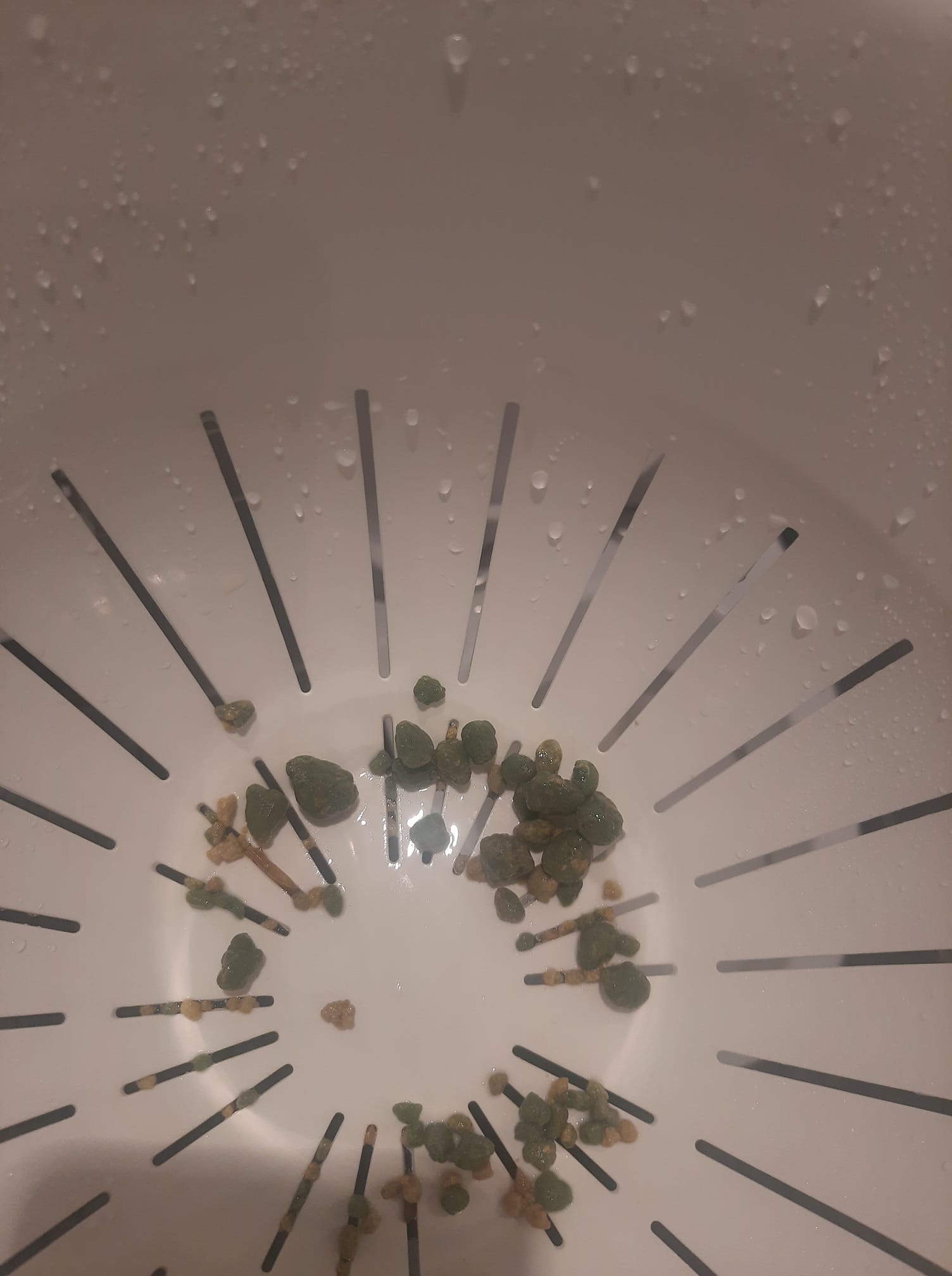
Alexandra
Sept 15 2022
THIS IS HUGE!
I promised to you guys to post my new scan results.
Today 15 Sept 2022 I had my new scan after 9 flushes.
The doctor confirmed that one of my 2x2 cm stones is GONE! The other one if the same size is still there.
She was very surprised, she saw the previous scan she took 2 years ago.
So, YES, it is possible to pass stones about 2 cm big when flushing using Hulda Clark protocol.
I will continue flushing til this one comes out and I will after that continue flushing for maintenance few times a year. 🎉🎉🎉
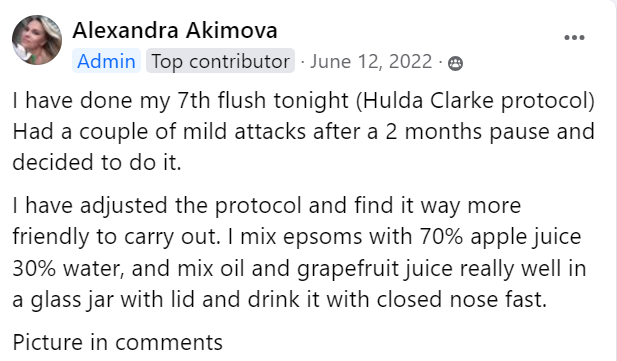
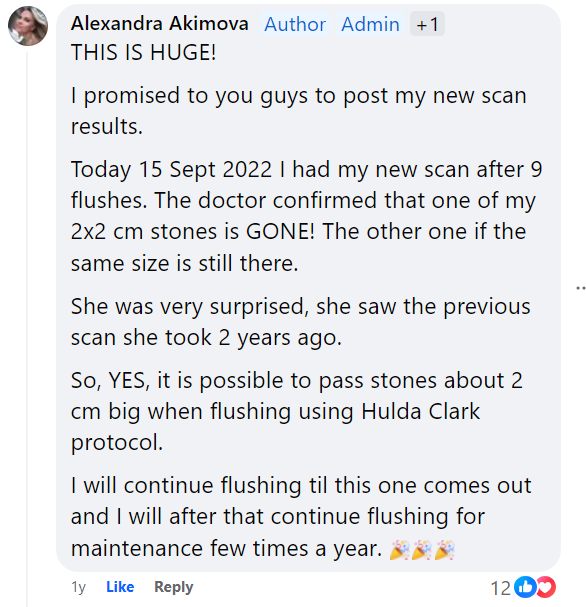
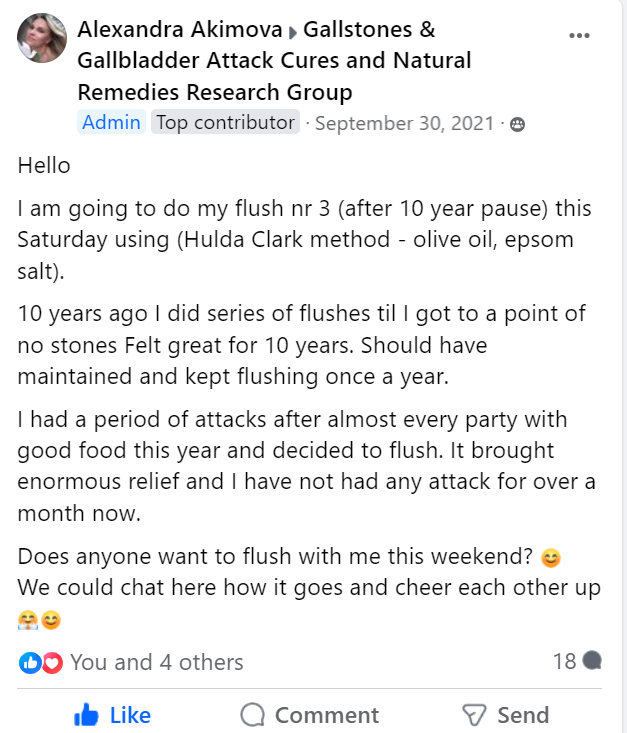
https://www.facebook.com/groups/gallstone/permalink/10160028834649469
-
https://www.curezone.org/upload/_A_Forums/Ask_MH/U...
MH 108 8
60 d
437
This is a reply to # 2,466,269
https://www.curezone.org/upload/_A_Forums/Ask_MH/Untitled_copy.jpg I think the boy was around 23 years old. Hulda liked my picture enough to print in her News Letter. MH Note: The big ....
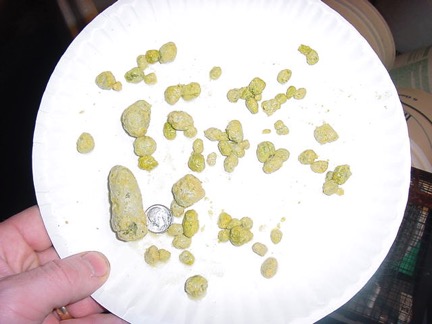
I think the boy was around 23 years old.
Hulda liked my picture enough to print in her News Letter.
MH
Note: The big stone is the size of the gallbladder!
All the other stones are from his Liver!
Those stones formed in his liver because WORMS ate holes in his liver and the mud settled in....
A normal-real Liver Flush done correctly removes 10# of mud out of the neck / chest!
-
https://www.curezone.org/upload/_A_Forums/Ask_MH/U...
MH 108 8
60 d
437
-
Expand this whole thread (9 messages)
SCIENCE: Good Evidence on the effectiveness of Liv... BSA SUCCESS Telman 11 y 13,499 † C †SCIENCE: Good Evidence on the effectiveness of Liver Flush in people with diagnosed Gallstones
I came across this article and it may be useful for those who need some evidence that liver-flushing can actually remove medically diagnosed Gallstones leaving the biliary route clear.
The link is a PDF format so you need a PDF reader to view it. The pages of interest are 24, 25, and 26. They show an ultra-sound examination report in 2003 a second in 2006 and the liver-flush diary.
//www.curezone.org/upload/Liver_Flush/Liver_Cleanse_thesis_By_Carugati_Crist...
http://www.drclark.net/images/stories/file/PDF/Liver_Cleanse_thesis.pdf
-
Re: Good Evidence
archus
11 y
10,260
This is a reply to # 2,220,849
Re: Good Evidence
Wow! This girl has done an awesome, thorough study of the Liver Flush. If a non believer reads it he/she sure will become a believer.
Thank you for posting this thesis of a student who has taken so much pain to study Liver-Flush and Kidney cleanse.
Great Job!
Archus-
Very great find Telman! I enjoyed reading the stor...
hanna
11 y
10,653
This is a reply to # 2,220,857
Very great find Telman! I enjoyed reading the story of the lady at the end. When she thought it was something different (heart?) instead of the gallbladder. I had that one evening I was debating t ....
Very great find Telman! I enjoyed reading the story of the lady at the end. When she thought it was something different (heart?) instead of the gallbladder. I had that one evening I was debating to call my husband who was, at all places at an ambulance meeting as a volunteer EMT, and I could just see everybody leaving the meeting. I just stayed quiet and waited and luckily it went away. My attacks have never been like I read from other people.
One time I was standing in the kitchen and all the sudden I felt sick like the flu for some reason it flew through my
mind that I always suggest to people on CZ to take 1 tbs ES
in warm water. Though I thought I had the flu, I tried it and it went away. It shows gallbladder problems can give you strange signals. Finally in May my gallbladder hurt also when I pushed on it, never happened before in 15 years,
so I figured time for surgery, even the ES was not helping.
We were half way to the ER and said to my husband let's turn back I feel fine again, so we did. Just for safety I made an appointment for an ultrasound. The US said 2.6cm stone, no thickened wall or inflammation. The MD said you might as well leave it alone since you have done ok so far.-
I was wondering if you should put it on some other...
RR Success hanna
11 y
10,825
This is a reply to # 2,220,921
I was wondering if you should put it on some other forums (not cross posted) like Crohn’s. Since doing the cleanses I don’t seem to have no where near the Crohn’s symptoms that I used to have ....
I was wondering if you should put it on some other forums (not cross posted) like Crohn's.
Since doing the cleanses I don’t seem to have no where near the Crohn’s symptoms that I used to have. My bloating has reduced, my nausea has gone and I’m not as constipated as I used to be. I no longer have diarrhea and my appetite has improved. The more cleanses that I do the more I keep improving and I’m keeping the weight off.
-
I think its one for the locker and I have download...
Telman
11 y
10,302
This is a reply to # 2,220,930
I think its one for the locker and I have downloaded the PDF and saved it. As you can see from the screenshot that despite receiving a high rating BSA the number of reads 183 are far less than ....
I think its one for the locker and I have downloaded the PDF and saved it.
As you can see from the screenshot that despite receiving a high rating BSA the number of reads 183 are far less than you post 373. I assume the figures are reads.
This would indicate that the content of a post isn't necessarily the most important factor.

If the moderator wants to share the post over a wider audience they are welcome.-
Interesting observation about the clicks.
About 1...
hanna
11 y
10,412
This is a reply to # 2,221,102
Interesting observation about the clicks. About 10 years ago I noticed that usually the first post got the most clicks. Then I tested it with a good Curezone link inside, say like a post from A ....
Interesting observation about the clicks.
About 10 years ago I noticed that usually the first post
got the most clicks. Then I tested it with a good Curezone
link inside, say like a post from Andreas. I needed a CZ post so I could see how many clicks the link got and it was only a couple %.
It probably means people like to read general information
and don't follow through with details. In this case with
the highest rating I have no answer for it. I can understand not everybody might be interested in the article but you would at least expect them to open the post.-
No offense. A lot of people like me have already ...
HotelParasite
10 y
8,804
This is a reply to # 2,221,110
No offense. A lot of people like me have already read the article. I think posting these things is always important even if it doesn’t seem to get the response you expected. Always share ever ....
No offense. A lot of people like me have already read the article.
I think posting these things is always important even if it doesn't seem to get the response you expected. Always share everything you can that may help.
-
No offense. A lot of people like me have already ...
HotelParasite
10 y
8,804
-
Interesting observation about the clicks.
About 1...
hanna
11 y
10,412
-
I think its one for the locker and I have download...
Telman
11 y
10,302
-
I was wondering if you should put it on some other...
RR Success hanna
11 y
10,825
-
Very great find Telman! I enjoyed reading the stor...
hanna
11 y
10,653
-
I have read this thesis and i don’t think it is a ...
david1o1
11 y
9,933
This is a reply to # 2,220,849
I have read this thesis and i don’t think it is a serious proof that liver flush is efficient to get rid of gallstones or liverstones, however take a look at this : http://www.liverflushtruth.blo ....
I have read this thesis and i don't think it is a serious proof that Liver Flush is efficient to get rid of Gallstones or liverstones, however take a look at this :
http://www.liverflushtruth.blogspot.ca/ -
Re: SCIENCE: Good Evidence on the effectiveness of...
paraboy
9 y
6,210
This is a reply to # 2,220,849
Re: SCIENCE: Good Evidence on the effectiveness of Liver Flush in people with diagnosed Gallstones
Here one from the literature
http://www.curezone.org/forums/am.asp?i=2325087
-
Re: Good Evidence
archus
11 y
10,260
-
Expand this whole thread (3 messages)
SCIENCE: Does Liver flushing flush out Vitamins to... quest 11 y 4,337 † C †SCIENCE: Does Liver flushing flush out Vitamins too?
I've done 27 Liver Flushes and I've been recently curious if flushing flushes out vitamins that are stored in the liver like A and B?-
Re: Does Liver flushing flush out Vitamins too?
R Educational Telman
11 y
4,382
This is a reply to # 2,169,840
Re: Does Liver flushing flush out Vitamins too?
It's a very good question.
Vitamins are stored and synthesized in the liver but are not seen in bile and therefore are not lost. Electrolytes and bile acids are the main loss. In the short term loss of bile acids will decrease the absorption of vitamins until there are replenished after about 12 days. In the long term a clean digestive system, bowel and liver, will improve the absorption of vitamins.-
Thanks for your thorough reply! Maybe that’s part ...
quest
11 y
3,345
This is a reply to # 2,170,287
Thanks for your thorough reply! Maybe that’s part of the reason we need to wait a couple of weeks in between cleanses.
Thanks for your thorough reply! Maybe that's part of the reason we need to wait a couple of weeks in between cleanses.
-
Thanks for your thorough reply! Maybe that’s part ...
quest
11 y
3,345
-
Re: Does Liver flushing flush out Vitamins too?
R Educational Telman
11 y
4,382
-
Expand this whole thread (5 messages)
EXPERIENCE: which malic acid is the best and most ... husky333 11 y 5,816 † C †EXPERIENCE: which malic acid is the best and most succesfull with liverlcleanses.
on ebay it has malic has acid powder for tart wine making 1kg for a decent price.. is this exactly the same thing, used for livercleanses aswell? but its just got a different name. as this sounds good cost wise. and i heard somewhere the poweder form is more powerful then the pill,tablet form, by miles.
And i wish to take malic acid over a 10 day period before the actual cleanse, not do the 2take a load on the actual day".iv had more success with taking applejuice over a 3 week perioid before. but then no success when taking a lot in one day.
oki so which combination , has made the maximun amount of stones come out for you.And be the most succesful flush.
As we all know the more the comes out the better. haha-
Re: which malic acid is the best and most succesfu...
R Telman
11 y
5,783
This is a reply to # 2,165,412
Re: which malic acid is the best and most succesfull with liverlcleanses.
There are two forms of Malic acid. D-Malic acid is produced artificially. L-Malic acid is the natural form. It is known by its 'E' number E296.
L-Malic acid is the preferred type. You need 2 to 3 grams a day taken with food and additional water. Too much can cause cramp and bloating.
You reach the maximum effect after 2 weeks and 75% after a week.
-
thankyou. is this l-malic acid also a bodybuilding...
husky333
11 y
4,843
This is a reply to # 2,165,560
thankyou. is this l-malic acid also a bodybuilding suplement. or does it just begin with l? Just wondering. oki. thankyou. !
thankyou. is this l-malic acid also a bodybuilding suplement. or does it just begin with l? Just wondering. oki. thankyou.<
-
thankyou. is this l-malic acid also a bodybuilding...
husky333
11 y
4,843
-
Re: which malic acid is the best and most succesfu...
R Telman
11 y
5,783

